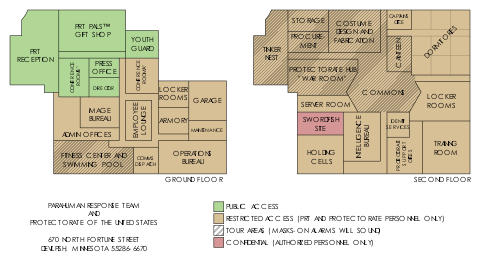Devilfish
Devilfish, Minnesota | |
|---|---|
|
City | |
| City of Devilfish | |
| Country | United States |
| State | Minnesota |
| County | Cook County, Minnesota |
| Founded | 1861 |
| Named for | Northern Pike |
| Government | |
| • Type | Commission |
| • Mayor | Susan Gilliam |
| • Commissioners |
|
| Area | |
| • City | 220 sq mi (600 km2) |
| Elevation | 620 ft (200 m) |
| Highest elevation (Eagle Mountain) | 2,301 ft (700 m) |
| Lowest elevation (Lake Superior) | 601 ft (200 m) |
| Population (2019) | 115,584 |
| • Urban | 254,812 |
| Demonym(s) | Devilfishian |
| Time zone | CST |
| • Summer (DST) | CDT |
| ZIP Codes |
55200-55299 |
| Area codes | 218 |
Devilfish is a city in the US state of Minnesota and the county seat of Cook County. Its metropolitan area comprises the third-largest in the state, after Minneapolis and (narrowly) Duluth. It is also the third-largest city on Lake Superior with a population of 252,447 in 2020.
The city has a rich history of mining dating back to the 1800s, however changing economic times have left the city in a financial slump. While reclamation (and associated industries) continue in some limited fashion, tourism and agriculture are beginning to take a larger share of the city's wealth.
"Devilfish" is a nickname for the Northern Pike, a fish common in the region, after which the city was named.
History
Early History
First inhabited by the Ojibwe people, European civilization was not familiar with the area until the late 1600s, when French fur traders began settling in the area. Several small settlements were made, largely centered on logging and fishing.
In 1854, the Grand Portage Indian Reservation was established as part of a treaty with the Ojibwe people. However, no less than twenty years later, significant copper reserves were found on and near the reservation land. The Grand Portage Mining Company, founded in 1876 by William J. Stannard, quickly established itself in the region.
The Grand Portage Mining Company
Stannard, through a combination of tactics such as bribery and ballot stuffing, quickly established his company as a local monopoly. By the late 1800s, almost 70% of Devilfish's workforce was paid by the GPMC or one of its subsidiaries. As his power grew, Stannard even had large swathes of the Grand Portage Reservation annexed, leaving only a small chunk of land remaining.
In the late 1800s, Devilfish was wracked by the so-called Union Wars, a series of conflicts lasting almost two decades between GMPC management and the Devilfish Brotherhood of Miners. Over 600 were killed in skirmishes between the workers and GMPC men, culminating in the Crescent Lake Massacre of 1899, when the National Guard was called in to evict striking DBM workers from a mine. Twenty were killed and another hundred injured, and after desperate negotiations mediated by the state, a tense stalemate has existed ever since.
As demand for copper rapidly rose in the 20th century, mining in Devilfish rapidly transitioned from underground mining to open pits. The largest of which, Farquhar Mine, remained operating until 2003. A combination of tightening environmental regulations and an abundance of cheaper foreign copper lead to mine closures beginning in the 70s. GMPC eventually went bankrupt in 1988, resulting in thousands losing pensions and retirement funds. The EPA to date has designated twenty-seven different Superfund sites in Cook County alone, as the successors to the GPMC have so far declined to address the century of pollution the city faces.
Changing Times
As the rest of the world reeled from the advent of parahumanity, Devilfish found itself relatively isolated, as few members of the emerging "cape culture" found themselves attracted to the former economic powerhouse. PRT records suggest that there weren't even any capes in the region until the 1992 trigger of the villain Tyrannochorus, although the common consensus is that those who triggered in Devilfish found better opportunities elsewhere.
However, as of 2019 a surge in parahuman activity has been seen in the Devilfish area, with the local PRT field office reporting a startling rise in parahuman-involved crime. The cause of the spike seems unclear, but ongoing plans are being made to address it.
Geography
Economy
Locations
Meta note: Any faction-specific locations will have a sidebar indicating the owner and mechanical details. This information may not be known in-character, please use your judgement.
Government
City Hall
Douglass Fender Federal Building
In 1890, a US Courthouse was erected here. However, in 1930 the structure was torched and razed by unemployed miners rioting. Six years later, as part of a WPA project, ground was broken at the site for the new "Northern Minnesota Courthouse and Federal Building".
The sixteen-story structure with its bronze spire was the tallest building in Devilfish until the completion of the GPMC Center in 1961. It stands as a magnificent example of the Art Deco style which has been preserved to this day.
In 1996 it was renamed to the Douglass A. Fender Federal Building and U.S. Courthouse, after a slain US Marshal who grew up in Devilfish. At that time it was also listed on the National Register of Historic Places.
After a spike in parahuman-related crime in mid-2019, the PRT began exploring site options for a new department headquarters. Options included buying one of several downtown structures, but eventually it was decided that the PRT would take over a portion of the first and second floors of the Federal Building. On July 9 2020, the department officially opened to little fanfare.
- Floorplans (click to enlarge images)
Cook County Courthouse
Public Safety
Devilfish Police Department Headquarters
The city’s police department has unfortunately suffered recent budget cuts, leading to a shortage of trained officers. After a shooting in 2015, all officers have been required to wear body cams.
Fort Calamity
- Mod note: This location has a notably strong security presence. If you are doing an event at this location, ping the Lore Mods and don't expect a fair fight.
This US Army base is located along the shores of Lake Superior, and the original 1800s-era post is preserved as a historic site, with public tours every weekday.
Devilfish Air National Guard Base
- Mod note: This location has a notably strong security presence. If you are doing an event at this location, ping the Lore Mods and don't expect a fair fight.
Located at Devilfish Airport, the 66th Fighter Wing provides air defense and air superiority for the region. They presently fly the F-15C/D Eagle. In addition, the US Coast Guard operates a helicopter detachment here, sharing facilities and resources.
Protectorate/PRT Headquarters
see #Douglass Fender Federal Building
Transportation
Devilfish International Airport (DSH)
The main commercial airport of the city. Primarily served by feeder routes heading to Minneapolis or Chicago.
Devil’s Track Seaplane Base (0G5)
Located on Devil’s Track Lake, this small airport is the core for general aviation traffic in the region. Contrary to its name, it features both a water runway and an asphalt strip along the shoreline.
Imperial Street Station
The city's historic train station, located just east of downtown. Aside from Amtrak service, it's also the central hub to the city's light rail service.
Hospitals
Mercy General Medical Center
The primary hospital in the region, located in the heart of downtown. It is a certified level II trauma center.
Saint René Hospital
An alternative to Mercy General, and operates many satellite clinics in the more remote areas.
Devilfish Health Center
Operated by the Indian Health Service, this small hospital provides medical care to the members of the Grand Portage Reservation.
Education
Eagle Mountain High School
Home of the creatively-chosen Eagles, this high school is the largest in Devilfish, with 3500+ students. A leaked internal memo shows that teachers have recently been required to take the PRT’s Wards Educator Training Seminar.
Divinity School
The local Christian combined school, this facility boasts the highest staff salary rates in the city, and a competitive sports program makes it a favorite for college scouts offering athletic scholarships.
Devilfish State University
The city’s public university, well-known for its mining engineering and geology programs.
Taylor College
Surrounding the shores of Taylor Lake, this community college recently started offering the city’s first PRT-accredited Parahuman Studies program.
Utilities
Blueberry Island Nuclear Power Station
- Mod note: This location has a notably strong security presence. If you are doing an event at this location, ping the Lore Mods and don't expect a fair fight.
Commissioned in 1968, this facility on the shores of Lake Superior supplies all of the region’s power (with the surplus being exported). After a controversial accident in 1989 (a safety interlock failed during routine maintenance, resulting in two worker fatalities), it was taken over by the Department of Energy and is currently run under the Midwest Power Administration.
Brule River Waste Treatment Plant
Recreation
Northshore Arena
Hockey is the big sport in the city, and this arena is where it all happens. Renovated in 2006, it’s home to the Devilfish Orediggers (and the ladies’ team, the Canaries).
Historical
The Pit
Officially known as Farquhar Mine, the Pit was at one time the largest operation of the Grand Portage Mining Company. It was closed in 2003 when it became too expensive to operate. Since then, it’s been slowly filling up with putrid brown water.
Colville
A small tourist trap on the shores of Lake Superior, this tiny community is a time capsule back to the early 1900s. Features a candy store (with fresh fudge and taffy!), a narrow-gauge scenic railroad, and a daily shootout at high noon.
Communities
Pineland Colony
The local Hutterite colony, established in 1927. Since their Minister was fatally shot by a drunk farmer a few years back, they’ve become rather isolationist.
Greenwood Lake Ranch
The Lowrys have a small little ranch a few miles out of town. Well-known for being troublemakers, they’re widely believed to be involved in regional organized crime.
The ranch also boasts a small gravel airstrip (MN22), which seems to have a lot of traffic heading to and from Canada with transponders disabled.
Grand Portage Indian Reservation
While most of the tribal lands were annexed during the city’s copper boom, a few square miles of Native land occupy the northeastern chunk of the region. They operate a fairly-successful casino.
Other
GPMC Center
The former headquarters of the Grand Portage Mining Company, now a multi-use skyscraper with offices, apartments, and a department store.

